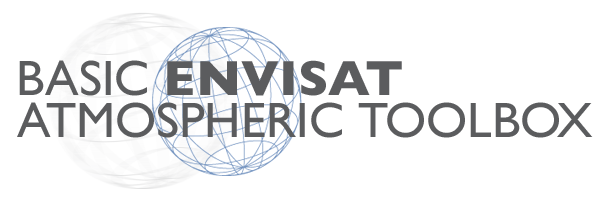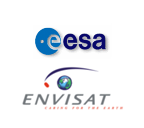
Latest versions:
| BEAT | - | 5.0.0 | (released on September 13, 2007; Release Notes) | |
| VISAN | - | 3.0.0 | (released on September 13, 2007; Release Notes) | |
| Tutorial | - | 2.2 | (released on November 26, 2007) | |
| GeoFit | - | 1.0.1 | (released on December 23, 2005; Release Notes) |
For an overview of known issues with these latest releases check the current issues page.
Introduction
The Basic Envisat Atmospheric Toolbox project (BEAT) aims to provide scientists with tools for ingesting, processing, and analyzing atmospheric remote sensing data.
The project consists of several software packages, with the main packages being BEAT and VISAN. The BEAT package contains a set of libraries, command line tools, and interfaces to IDL, MATLAB, Fortran, and Python that allow you to access data from a range of atmospheric instrument product files. The VISAN package contains an application that can be used to visualise and analyse the data that you retrieve using the BEAT interface. A full overview of the BEAT packages can be found below.
The primary instruments supported by BEAT are GOMOS, MIPAS, and SCIAMACHY (ENVISAT), GOME (ERS-2), OMI, TES and MLS (Aura), and GOME-2 and IASI (MetOp).
BEAT, VISAN, and GeoFit are provided as Open Source Software, enabling user community participation in further development and quality improvement.
BEAT Overview
BEAT consists of the following parts:
| BEAT | : | The core part of the toolbox is the BEAT package itself. This package
provides data ingestion functionality for each of the supported
instruments. The data access functionality is provided via two different
layers, called BEAT-I and BEAT-II: BEAT-I The first layer of BEAT provides direct access to data inside each of the 75+ product files that are supported by BEAT (this includes level 0 through level 4 data and auxiliary data, but also HDF4, HDF5, netCDF, and XML files). The supported instruments include GOMOS, MIPAS, SCIAMACHY, GOME, OMI, TES, and MLS. All product file data is accessible via the BEAT-I C library. On top of this C library there are several interfaces available to directly ingest product data using e.g. Fortran, IDL, MATLAB, and Python. Furthermore, BEAT also comes with a set of command line tools (beatcheck, beatdump, and beatfind). All BEAT layer 1 functionality is included in the BEAT package. BEAT-II The second layer of BEAT provides an abstraction to the product data to make it easier for the user to get the most important data from a product. Using only a single command you will be able to ingest product data (from one or more files) into one of a set of flexible data types for spectral readout data, profile data, ground pixel data, etc. These predefined data types make it easier to compare similar data coming from different instruments and also simplifies the creation of general visualisation routines. Furthermore, the BEAT-II layer provides some additional functions to manipulate and import/export these special data types. The layer 2 interface is build on top of the BEAT-I C library, but BEAT-II also supports reading of additional products that are stored in, for instance, ASCII, HDF4, or HDF5 format. All BEAT-II functionality is accessible via the BEAT-II C library that is included in the BEAT package. The BEAT package contains interfaces of BEAT-II for Fortran, IDL, MATLAB, and Python, and a command line tool (beatl2dump). |
| VISAN | : | VISAN is a cross-platform visualization and analysis application for atmospheric data. The application uses the Python language as the means through which you provide commands to the application. The Python interfaces for BEAT-I and BEAT-II are included so you can directly ingest product data from within VISAN. Using the Python language and some additional included mathematical packages you will be able to perform analysis on your data. Finally, VISAN provides some very powerful visualization functionality for 2D plots and worldplots. |
| Scientific Tutorial | : | The BEAT Scientific Tutorial, created in co-operation with KNMI, provides an introduction to BEAT and its capabilities for use in atmospheric science. By using a number of real-life scientific case studies, the tutorial shows how one can use the BEAT tools to proceed from asking a scientifically interesting question to answering it. The tutorial consists of one VISAN example and three IDL examples. The examples cover both BEAT interfaces (BEAT-I and BEAT-II), all ENVISAT atmospheric intruments, and both level-1, level-2, and level-3/4 data products. The tutorial can be run on Windows and Unix based platforms. |
| GeoFit | : | GeoFit is the MIPAS Special Modes processor developed by the University of Bologna, Italy. GeoFit can retrieve atmospheric constituents from a set of spectroscopic measurements coming from MIPAS Level 1b data. The retrieval system is based on the GeoFit and Multi Target Retrieval (MTR) approaches (more about these approaches can be found in the GeoFit documentation). GeoFit is capable of processing MIPAS special modes measurements and retrieving additional species not provided by ESA's NRT processor, but can also be used to re-process measurements obtained in nominal observation mode to improve the accuracy of the results. Furthermore, GeoFit is provided as Open Source software, which means that you will have access to the Fortran source code and will be free to apply modifications (under your own responsibility) to the retrieval software. It should be noted that GeoFit is not suitable to analyse daytime measurements operated with the "Upper Atmosphere" observation modes because Non Local Thermal Equilibrium (NLTE) is not modelled by this retrieval system. |
| Data Files | : | On the download page you can also find a set of data files, such as sample products for GOME (level 1, level 2, and level 4) and a Reference Spectra Database file for GOME and SCIAMACHY (courtesy of the Molecular Spectroscopy Group of the Institute for Environmental Physics of the University of Bremen). |
To download any of the mentioned packages, please go to the download page.
More information about the BEAT and VISAN packages can be found in the on-line BEAT documentation and VISAN documentation.
Supported Platforms and Languages
Supported platforms include:
- Linux
- Mac OS X
- Microsoft Windows
- Sun Solaris
It should be possible to use the BEAT package on other Unix platforms (IBM AIX, SGI Irix, HP/UX, BSD, etcetera) as well, since the entire system is implemented in portable ANSI-C code. However, these platforms are not routinely tested and may therefore require more effort during installation.
The VISAN application is currently only supported on Windows, Linux, and Mac OS X.
GeoFit is officially supported for the Intel Linux and Compaq Alpha (Tru64 Unix) platforms. However, it is written using portable C and Fortran code, so it should be usuable on other platforms too. Your target machine should have at least 2GBytes of RAM (2.6GBytes when processing a full orbit with S6 special-mode measurements) and 20GBytes of free hard disk space in order to run GeoFit.
Because BEAT is an open-source effort, users are actively encouraged to send any installation reports, suggestions and/or patches that can improve stability, usability, or cross-platform compatibility. Contributions will be integrated into the main distributions of BEAT, VISAN, GeoFit, etc.
Acknowledgements
| The development of the Basic Envisat Atmospheric Toolbox is primarily
funded by the European Space Agency
(ESA). ESA Project Manager: Claus Zehner |
 |
| The development of GOME-2 and IASI data product support in the toolbox
is funded by EUMETSAT. |
 |
| BEAT and VISAN are designed, developed and maintained by S&T. |
 |
The BEAT Scientific Tutorial was created by the Royal Netherlands Meteorological Institute (KNMI).
GeoFit is developed and maintained by the University of Bologna, Italy.
The initial design of BEAT and VISAN was performed in co-operation with Space Systems Finland Ltd.
In addition we would like to thank the following people who have contributed to BEAT by means of suggestions, discussions, and installation reports:
Stefano Casadio (ESRIN), Jos van Geffen (KNMI), Richard van Hees (SRON), Matthijs Krijger (SRON), Ankie Piters (KNMI), Coen Schrijvers (TNO/TPD), Anne Grete Straume (SRON), Renske Timmermans (KNMI), Pekka Verronen (FMI), Ellen Brinksma (KNMI), Gijs van Soest (KNMI), Mark Kroon (KNMI), Yasjka Meijer (RIVM), and Walter Zimmer (DLR).
Support and Feedback
Please send an e-mail to beat@stcorp.nl if you have any questions and/or remarks regarding BEAT (including VISAN and GeoFit).
Also be sure to check the current issues page to see if a problem that you are faced with is not already mentioned there.

